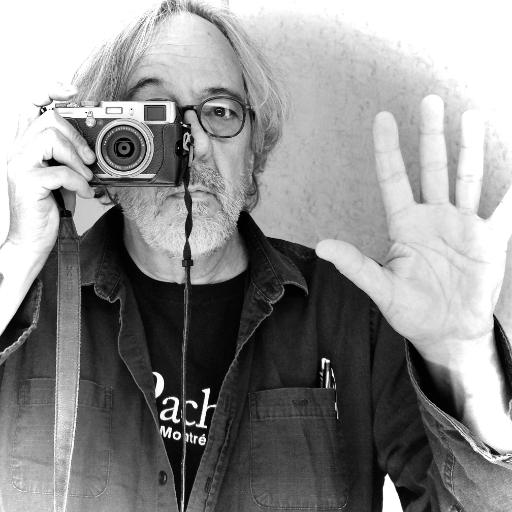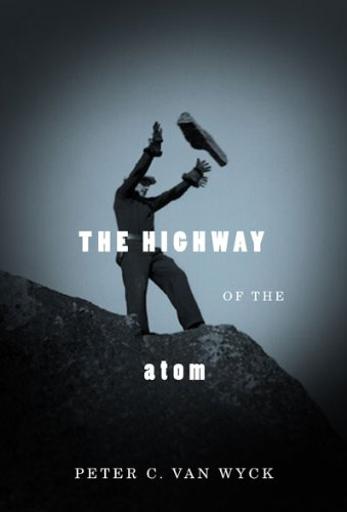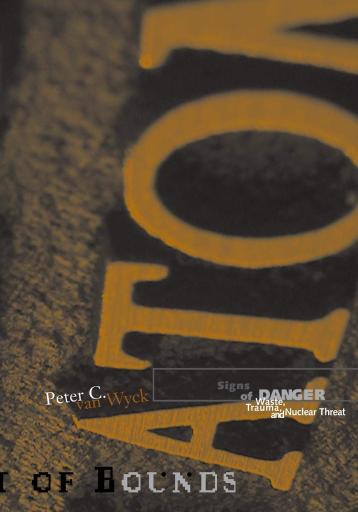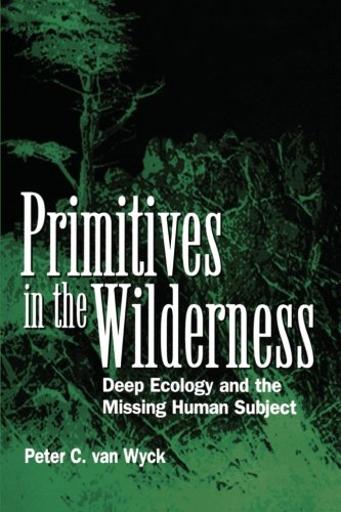
Bathroom at Onkalo Deep Geological Repository, Olkiluoto, Finland
Dr. Peter C. van Wyck, PhD
- Professor, Communication Studies
status: Not accepting new graduate students
Are you the profile owner?
Sign in to editResearch areas: environmental and ecological humanities; atomic photography; nuclear and atomic history and aesthetics; cultural theory; writing as method; north and nordicity; monuments, archives and memory; risk and futurity
Contact information
Email:
Availability:
Biography
Education
Forest Technology Dip., Sir Sandford Fleming College, 1983
BSc, Environmental Science / Social Ecology, Trent University, 1987
MA, Methodologies for the Study of Western History Culture, Trent University, 1992
PhD, Graduate Program in Communication, McGill University, 1997
Postdoctoral Fellow, Methodologies for the Study of Western History and Culture / Environmental Studies – SSHRC, Trent University, 1997-1999
Postdoctoral Fellow, Interdisciplinary Postdoctoral Fellow in the Humanities (formerly Webster Fellowship) and Assistant Professor of Geography, Queen’s University, 1999-2000
Academic Life
I am a researcher, writer, teacher, and photographer with a background in forestry, environmental and ecological sciences (with a focus on wetlands), continental philosophy, environmental and cultural studies, and communication and media studies. This broad interdisciplinary training informs my ongoing commitment to what is now often called the Environmental Humanities.
At Concordia, I teach undergraduate and graduate courses across the fields of semiotics, communication theory, visual culture, and photographic theory. My seminar offerings have included Reading Freud; Theory in a Cold Climate; The Arts of Memory; Landscapes of the Local: Rethinking Space and Place; and Landscapes of the Sign: The Place of the Photographic Image.
My current research engages with the theory and philosophy of communication, the semiotics of environment, and the intersecting histories of landscape, memory, and atomic culture. I’m particularly interested in nuclear and radiation histories, critical topographies, and the entangled discourses of North and nordicity. These concerns often converge in my writing on topics such as nuclear waste, apology, justice, and environmental memory—from tsunami stones and the Anthropocene to the Cloud Chamber and survivor trees.
In 2024, I was awarded a five-year SSHRC Insight Grant, in collaboration with Dr. Myra Hird (Queen’s University), for a project entitled Greening the Atom. The project investigates Canada’s climate-driven nuclear resurgence and the reframing of nuclear energy as “green.” With particular attention to the rise of Small Modular Reactors (SMRs), it examines the political, environmental, and ethical stakes of this transformation—especially in relation to energy justice, sovereignty, and long-term waste management. From this work, a new book is emerging, tentatively titled The Angel Turns: Memos for the End of the Holocene.
This project builds on our earlier SSHRC-funded collaboration on nuclear waste, the media of apology, and the ethics of futurity. I continue to write on related subjects, including the Japanese relationship with the atom, the figure of Harold Jacobson, and the overlooked geographies of waste and remembrance.
My last book, The Highway of the Atom (McGill-Queen’s University Press, 2010), received the 2011 Gertrude J. Robinson Book Prize from the Canadian Communication Association and was shortlisted for the 2012 Harold Adams Innis Award (Canada Prize in the Social Sciences). My earlier work includes Signs of Danger: Waste, Trauma, and Nuclear Threat (University of Minnesota Press, 2005), also awarded the Robinson Prize, and Primitives in the Wilderness: Deep Ecology and the Missing Human Subject (1997).
In 2019, I was invited to join the Atomic Photographers Guild, an international group committed to documenting the nuclear era through photographic practice.



Teaching activities
Winter 2025
COMS 240
Communication Theory
Fall 2025
COMS 240
Communication Theory
Recent and Ongoing Work
Selected Texts
“Reading the Remains,” Commissioned Essay for Artist’s Catalogue, Mary Kavanagh, Daughters of Uranium, Southern Alberta Art Gallery. Publication date: January 2020, 45-54.
“The Atom comes to Town,” Commissioned text for Whistlestop Productions, CBC Documentary Channel, 03/2024
“Topographies of Loss,” Terms – Depression, Part 1. Topography. Galerie Leonard & Bina Art Gallery. Fall 2023.
“The Anthropocene’s Signature.” The Nuclear Culture Source Book, ed. Ele Carpenter. Black Dog Publishing in partnership with Bildmuseet, Sweden and Arts Catalyst, London, 2016, pp. 23-30.
“A Note on Common Ground,” The Goose – Association for Literature, Environment, and Culture in Canada / Association pour la littérature, l'environnement et la culture au Canada.
"What was the Anthropocene?" with Myra Hird. Chapter invited for volume Assembling the Planet: The Post-War Politics of Globality. Rens van Munster and Casper Sylvest (eds.), Routledge London. Accepted. A version of this text was given as the Leverhulme Lecture with Myra Hird, Lancaster University, June 2014.
Recent and upcoming talks
2024-2025
Keynote, “Hobos of Thought,” Nuclear Futures Online Symposium.” Anna Storm & Thomas Keating (Linköping University). September 11, 2024
2020-2021
2018-2019
Invited Lecture, Mary Kavanagh's Uranium's Daughters, Founders' Gallery, University of Calgary, November 2019
2017-2018
On leave.
2016-2017
Talk and PhD Seminar at the Centre for Research Architecture, Goldsmiths University of London, Spring 2017
“Deep Uncertainty” Perpetual Uncertainty: Art and the Deep Time of Radiation. Panelist and facilitator. Bildmuseet, Umeå University, Sweden, November.
Lines of Flight: A reading” With Julie Salverson. Queen’s University, Kingston, September.
Plenary Panel. "Nuclear Imprescriptibility in the Late Holocene." Association for Literature, Environment, and Culture in Canada (ALECC), Kingston, June.
2014-2015
“The lens of Fukushima: an inventory of afters,” Invited talk, with Julie Salverson, “Through Post-Atomic Eyes: Toxic Legacies, Post-nuclear Futures,” OCAD University and Art Gallery of Ontario, October 2015.
Invited Discussant, Session on Life, for Infrastructure, Environment and Life in the Anthropocene,” SSHRC workshop, Concordia University, October 20.
“Placing the Anthropocene,” Invited talk for the Critical Topography Symposium session on Forensic Landscape and the Nuclear Paradigm. Ryerson and Trent University, May 20.
“Journeys Along the Atomic Highway: History, Politics, Performance and Memoir,” Invited Lecture, with Julie Salverson. Sophia University Institute of Comparative Culture, Sophia University, Tokyo, April 20.
“From Great Bear Lake to Japan,” Invited talk, with Julie Salverson. International Symposium: From Hiroshima and Bikini to Fukushima and the World – Exchanging the voices and actions of the citizens, Japanese Scientists’ Association Fukushima Branch, Fukushima University, April 11.
"The Uranium Highway from Great Bear Lake, Canada to Hiroshima," Invited Lecture, with Julie Salverson, HPI Research Forum, Hiroshima Peace Institute, Japan, April 7.
“The Trail of the Atom: Image, Witness and Archive,” Invited talk. Faculty of Fine Arts, University of Regina, March 10.
Invited Talk, Nuclear Waste Management Organization of Japan, Tokyo, April.
“The Anthropocene’s Archive,” Keynote at “Construire la mémoire: An International Conference and Debate on the Preservation of Records, Knowledge and Memory of Radioactive Waste across Generations.” Organisation for Economic Co-operation and Development (OECD), and the Nuclear Energy Association (NEA), Verdun, France. September.
Selected Publications
Books
The Angel Turns: Writing at the End of the Holocene, monograph in preparation.
Theory in a Cold Climate: Cultural Studies of the Canadian North. Topia: Canadian Journal of Cultural Studies 32 (Fall 2014).
The Highway of the Atom, Montreal: McGill-Queen’s University Press, 2010.
Signs of Danger: Waste, Trauma, and Nuclear Threat. Minneapolis: Theory out of Bounds series, University of Minnesota Press, 2005.
Primitives in the Wilderness: Deep Ecology and the Missing Human Subject. Albany: State University of New York Press, 1997.
Selected Essays and other Writing
“Signing the Holocene,” in Critical Topographies. eds., Jonathan Bordo and Blake Fitzpatrick. McGill-Queen’s University Press. 2023.
“Nuclear Topographies,” Review Essay of Hot Spotter’s Report: Military Fables of Toxic Waste (Krupar), Environment and Planning D: Society and Space. Online, May 3, 2014.
“An Archive of Threat.” Future Anterior, 9.2 Winter (2013): 53-80.
“The ciphered river of the streets – being a very preliminary collection of notes and thoughts toward an abécédaire for young people, with particular reference to the conditions of life during the printemps érable.” Out of the mouths of “casseroles” / textes qui bougent au rythme du carré rouge. A special open-wi issue of wi: journal of mobile media, part II, 19 june 2012.
Numbering Numbers: Urban Semiology and Practical Pedagogy. With June Ying-Li Aldinucci. Juried exhibition “Archives and the City,” with the Universities Art Association of Canada/ Association d’art des universities du Canada (UAAC) Conference hosted by Concordia University, November.
"An Emphatic Geography: Notes on the Ethical Itinerary of Landscape." Canadian Journal of Communication 33.2 (2008): 171-91.
“The Highway of the Atom: Recollections along a route” Topia 7 (Spring 2002): 99-115.
“The American Monument,” Alphabet City, No. 8 (Lost in the Archives, 2002): 740-767.


